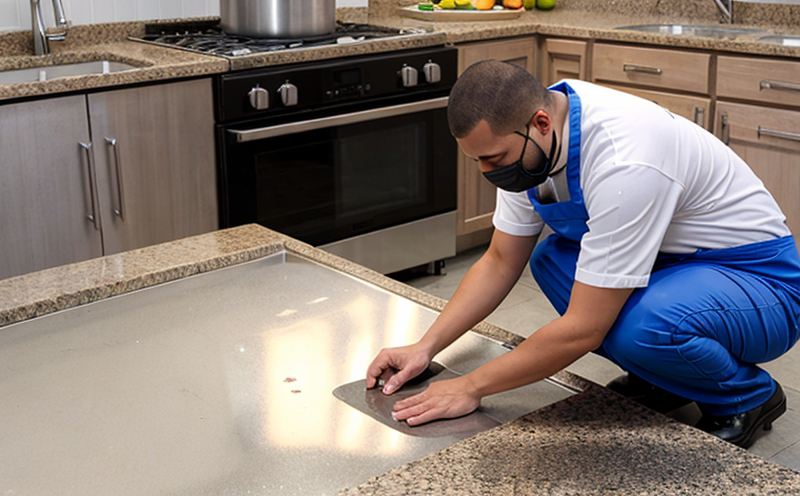Food preparation surface inspection
The food industry is a cornerstone of global health and economic stability. Ensuring that surfaces used in food preparation are clean, safe, and hygienic is paramount to preventing contamination and safeguarding public health. Food preparation surfaces include countertops, tables, cutting boards, and any other contact points where raw foods may come into direct or indirect contact with finished products.
Contaminated surfaces can harbor harmful microorganisms such as bacteria (e.g., Salmonella, Listeria), viruses, and parasites that can lead to foodborne illnesses. The World Health Organization (WHO) recommends strict hygiene practices during all stages of food production, processing, distribution, and consumption. This includes the rigorous inspection of preparation surfaces.
At Eurolab, we provide comprehensive inspections for food preparation surfaces using advanced microbiological methods compliant with international standards such as ISO 18675:2020 and EN ISO/TS 22324:2020. Our services help ensure that businesses comply with local and global regulations, thereby protecting their reputation and consumer trust.
Our approach involves a multi-step process to assess the microbiological quality of surfaces. This includes:
- Culture-based methods for detecting specific pathogens
- Molecular techniques like PCR (Polymerase Chain Reaction) for rapid detection of microorganisms
- Adenosine triphosphate (ATP) bioluminescence testing to measure the presence of organic matter indicating recent food contact
- Visual inspection by trained personnel to identify visible contamination or biofilm growth
By leveraging these techniques, we provide a holistic assessment that goes beyond mere visual inspection. Our reports include detailed findings and recommendations tailored for our clients' specific needs.
The importance of this service cannot be overstated in today's world where food safety is a critical issue. Proper surface hygiene directly impacts the quality of the final product and consumer health. It is essential to monitor these surfaces regularly, especially during peak production times or after unusual events that may increase contamination risks.
Scope and Methodology
The scope of food preparation surface inspection covers a wide range of surfaces used in various types of food establishments, including restaurants, cafeterias, food processing plants, and retail outlets. Our methodology is designed to ensure thoroughness and accuracy.
We begin by gathering detailed information about the specific surfaces to be inspected, their usage patterns, and any recent incidents or changes that might affect microbial load. This helps us tailor our approach to each client's unique requirements.
The inspection process typically involves:
- Sampling: Selecting representative areas of the surface for testing
- Culture media: Applying appropriate growth mediums to detect specific pathogens
- Molecular analysis: Using PCR technology to identify DNA/RNA sequences from potential contaminants
- ATP measurement: Assessing residual organic material indicative of recent food contact
- Data analysis: Compiling results into a comprehensive report including actionable insights
All samples are analyzed in our accredited laboratory adhering strictly to relevant international standards. The final report is delivered within a specified timeframe, ensuring that clients receive timely feedback.
Benefits
- Enhanced food safety: Detect and eliminate potential sources of contamination before they affect the product or clientele.
- Compliance with regulations: Ensure adherence to international standards like ISO 18675:2020, EN ISO/TS 22324:2020, and local legislation.
- Improved customer confidence: Demonstrating a commitment to hygiene can significantly boost brand reputation and consumer trust.
- Risk management: Identify potential hazards early, allowing for proactive measures that minimize the risk of recalls or health scares.
- Operational efficiency: Efficient cleaning protocols based on inspection results enhance overall productivity without compromising quality.
- Data-driven decisions: Insights from regular inspections inform strategic improvements in hygiene practices and infrastructure.
By implementing these benefits, businesses not only meet regulatory requirements but also set themselves apart as leaders in food safety and hygiene. These advantages contribute to a safer work environment for employees and peace of mind for consumers.
Eurolab Advantages
EuroLab offers unparalleled expertise in the field of food safety and hygiene inspection, providing services that are second-to-none. Our team consists of highly qualified professionals with extensive experience in microbiology, chemistry, and quality management. Here’s why you should choose us:
- Accreditation: Our laboratory is fully accredited by leading bodies ensuring the highest level of reliability.
- State-of-the-art equipment: Utilize cutting-edge technology for precise and reliable results.
- Comprehensive services: From initial consultation to final reporting, we cover every aspect of food surface hygiene inspection.
- Dedicated support: Our client-focused approach ensures that you receive personalized service and advice tailored to your unique needs.
- Timely delivery: Rapid turnaround times mean quicker decision-making and fewer disruptions in operations.
- Continuous improvement: Stay ahead of industry trends with our ongoing research and development efforts.
With EuroLab, you can trust that your food safety practices are robust, effective, and compliant. Our commitment to excellence ensures that every inspection is conducted with the utmost precision and integrity.





